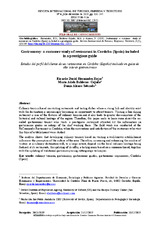Mostrar el registro sencillo del ítem
Gastronomy: a customer study of restaurant in Cordoba (Spain) included in a prestigious guide
| dc.contributor.author | Hernández Rojas, Enrique David | |
| dc.contributor.author | Balderas-Cejudo, María Adela | |
| dc.contributor.author | Alonso Sobrado, Dunia | |
| dc.date.accessioned | 2020-01-10T09:17:59Z | |
| dc.date.available | 2020-01-10T09:17:59Z | |
| dc.date.issued | 2019 | |
| dc.identifier.issn | 2530-7134 | |
| dc.identifier.uri | http://hdl.handle.net/10396/19263 | |
| dc.description.abstract | Culinary tourism based on visiting restaurants and tasting dishes where a strong link and identity exist with the destination is increasingly becoming an opportunity to attract tourists. Visiting a fine-dining restaurant is one of the features of culinary tourism and it also leads to greater dissemination of the historical and cultural heritage of the region. Therefore, this paper seeks to learn more about the socalled gastronomic tourist who visits a prestigious restaurant attracted by the information in gastronomic guides or ratings of the chef working there. The field work was conducted at the ReComiendo Restaurant in Cordoba, when the motivations and satisfaction of the customers who visit this type of establishment were studied. The analysis shows that developing culinary tourism based on visiting a well-known establishment influences the perception of the culture of the area. Therefore, increasing and enhancing the number of visitors at a culinary destination will, to a large extent, depend on the local culinary heritage being featured at its restaurants, the updating of its offer, a tasting menu based on a common thread, together with the updating of traditional gastronomy using cutting-edge techniques. | es_ES |
| dc.description.abstract | El turismo culinario basado en visitar restaurantes y probar platos que mantienen un fuerte vínculo e identidad con las tradiciones culturales del destino, se está convirtiendo cada vez más en una oportunidad para atraer turistas. Visitar un restaurante de alta cocina es una de las características del turismo culinario y también conduce a una mayor difusión del patrimonio histórico y cultural de la región visitada. Por lo tanto, este trabajo busca aprender más sobre el llamado turista gastronómico que visita un prestigioso restaurante atraído por la información existente en las guías gastronómicas o las calificaciones del chef que trabaja allí. El trabajo de campo se realizó en el restaurante “ReComiendo” de Córdoba, donde se estudiaron las motivaciones y la satisfacción de los clientes que visitan este tipo de establecimientos. El análisis muestra que el desarrollo del turismo culinario basado en la visita a un establecimiento conocido influye en la percepción de la cultura y la oferta turística de la zona. Por lo tanto, aumentar y mejorar el número de visitantes en un destino culinario dependerá, en gran medida, del patrimonio culinario local que se presenta en sus restaurantes, la actualización de su oferta, un menú de degustación basado en un hilo común, junto con la innovación de la gastronomía tradicional utilizando técnicas de vanguardia. | es_ES |
| dc.format.mimetype | application/pdf | es_ES |
| dc.language.iso | eng | es_ES |
| dc.publisher | UCOPress | es_ES |
| dc.rights | https://creativecommons.org/licenses/by-nc/4.0/ | es_ES |
| dc.source | Revista Internacional de Turismo, Empresa y Territorio (RITUREM) 3(2), 131-145 (2019) | es_ES |
| dc.subject | Culinary tourism | es_ES |
| dc.subject | Gastronomy | es_ES |
| dc.subject | Gastronomic guides | es_ES |
| dc.subject | Gastronomic experiences | es_ES |
| dc.subject | Turismo gastronómico | es_ES |
| dc.subject | Gastronomía | es_ES |
| dc.subject | Guías gastronómicas | es_ES |
| dc.subject | Experiencias gastronómicas | es_ES |
| dc.subject | Córdoba (España) | es_ES |
| dc.title | Gastronomy: a customer study of restaurant in Cordoba (Spain) included in a prestigious guide | es_ES |
| dc.title.alternative | Estudio del perfil del cliente de un restaurante en Córdoba (España) incluido en guías de alto interés gastronómico | es_ES |
| dc.type | info:eu-repo/semantics/article | es_ES |
| dc.relation.publisherversion | http://www.uco.es/ucopress/ojs/index.php/riturem/index | es_ES |
| dc.rights.accessRights | info:eu-repo/semantics/openAccess | es_ES |

